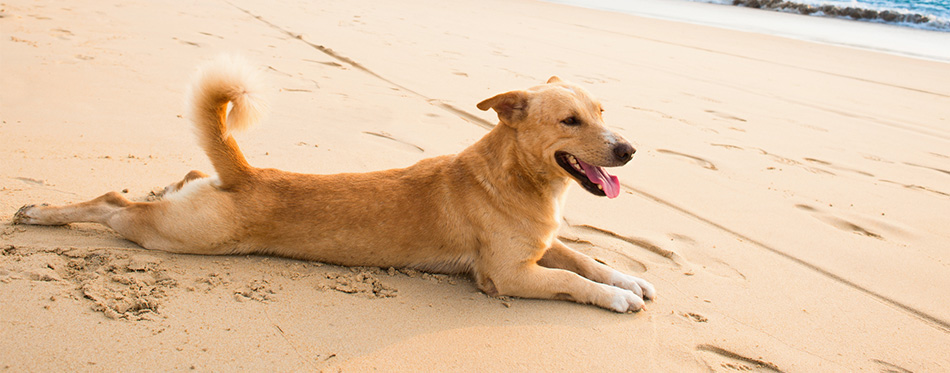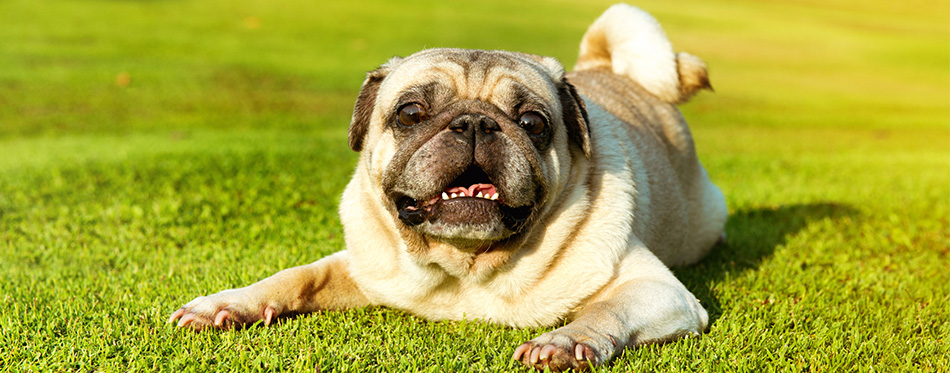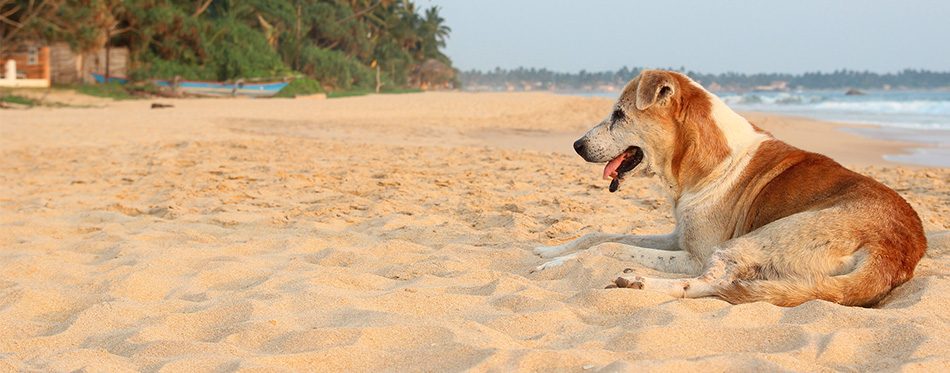In the summer months, it’s common to want to be out in the sunshine as much as possible. It’s the season of beach trips, ice-cream trucks and long walks in the sun – but it also happens to be the season of red, blotchy and painful sunburn. It’s something we humans are accustomed to. We lather ourselves in SPF 50, we cover up and we are cautious about staying out of the sun during the hottest part of the day, in the hope of avoiding a nasty case of sunburn. But there is one thing we rarely give a second thought to: our dogs skin.
Since most dog breeds are covered in a layer of fur, it’s common to think that our canine counterparts are protected from the harsh rays of the sun. The reality? Dogs are just as likely to get sunburn as humans, and it’s vital we put just as much consideration into their sun safety as we do our own. Dogs won’t leave the beach with a golden tan, but they can get sunburnt – and there is a lot we can do to prevent it.

Dog Breeds Most Likely to Sunburn
All dogs can get sunburn, but there are some breeds who are considerably more at risk than others. Just as fair-skinned or light-haired humans are more likely to burn in the sun, unsurprisingly, hairless breeds and those with light fur are also at greater risk, and it’s important to be extra vigilant with sun protection for them. Although not an exhaustive list, the breeds at a greater risk of burning are:
- Boxer
- Dalmatian
- Greyhound
- Chinese Crested
- Weimaraner
- Whippet
- White German Shepherd
The areas that are most likely to sunburn first are the tips of the ears, the nose, the tip of the tail and the belly. Depending on the breed of the dog, the area around the mouth and eyes can be extremely sensitive to sunburn as well. Other risks also include bald spots, light-coloured noses and post surgery stitches. It’s important that you are extra vigilant to these areas to prevent your pup from getting burnt.
You may also like our article on Dog Cooling Vests.
How to Stop Your Dog From Getting Sunburnt
Just because your dog can get sunburn, doesn’t mean they have to. In the same way there are precautions you can take to protect your own skin, there are things you can do to protect your pup from the rays of the sun and ensure you can both enjoy summer to the fullest! Make yourself aware of the parts of your dog which are most likely to get sunburn. You can then take precautionary steps to protect these areas and keep your pup happy and thriving in the warmer months:
- Avoid walks at the hottest part of the day
If possible, avoid taking your dog out when the sun is at the highest point in the sky. This is generally between the hours of 10pm and 4pm, and it’s recommended that your dog stays indoors in this time. Early morning or late evening walks are an ideal alternative and reduce the risk of your pup getting burnt.
- Apply sunscreen
Sunscreen for dogs may seem like a faff but it is well worth it to provide your canine friend with that extra bit of protection. It should be applied to the areas more susceptible to burning: around the nose, the tips of the ears, the belly and the mouth. Be sure to choose a doggy-sunscreen that contains no zinc oxide or PABA, with an SPF of at least 15. Your local pet store will be able to point you in the direction of an FDA approved option that will give you the piece of mind you need. Always be sure to spot check first to be sure that your pups delicate skin won’t react badly to it before lathering it on. You’ll need to reapply your dogs sunscreen if they take a dip or rolls around in grass or sand – especially if the sunscreen isn’t waterproof!
- Cover up
In the hottest months, when you can feel the rays on your shoulders and that oh-so familiar twinge of the first signs of burning, you’ll cover up before doing anything else. Apply the same precautions with your dog. There is doggy-specific UV wear that can protect the sensitive belly area, while being lightweight enough to prevent overheating. If your caught by surprise by a hot day, an alternative is to dampen a light t-shirt and drape it over your pup’s back. It will act as a cold compress, and a barrier to the harsh UV rays.
- Keep them in the shade
Naturally, one of the easiest ways to keep your pup safe from the sun is just to keep them out of it. While it’s not always possible to stay keep them indoors, it is easy to keep them out of the direct rays with a little bit of extra effort. Your dog will instinctively look for shade and shelter from the sun when it becomes too much to bear – make it easier for them by investing in an outdoor kennel with a sun-block, a large umbrella or a tent that can offer UVA protection. For a wider selection of choices, check out our dog umbrellas and dog tents guide.

How Can I Tell If My Dog Has Sunburn
The tell-tale signs for sunburn in canines are much the same as those in humans. The most obvious sign will be skin-redness, this can develop almost instantly but is not always easy to spot if your pup is long-haired. Be vigilant to it, keeping an eye out for the other signs of sunburn in dogs. Other symptoms of sunburn can be:
- Discomfort or objection to the touch of affected areas.
- Hair loss.
- Blistering or ulceration of skin.
- Cracked, curled or dry edges of your pups ears.
In other more extreme cases, your dog may also experience weakness, fainting and shock due to heat exhaustion. If you believe this may be the case, please consult your local veterinary doctor immediately.
What to Do If Your Dog Gets Sunburnt
For the most part, sunburn in dogs a minor ailment. Although uncomfortable, in most cases it can be treated entirely at home and there are many ways you can help ease your canine’s discomfort.
- Cool the area
One of the most simple but effective ways to alleviate the pain from sunburn is using a cold water mist from a spray bottle every half hour or so. This will cool the area, providing a welcomed relief. If your dog does not like the spray bottle, a cold compress or oatmeal soak will also work wonders to soothe the damaged skin. While these won’t help to aid the healing process, they will make your pup feel a whole lot better.
Check out our guide on Dog Cooling Pads.
- Encourage the healing process
If you have a more serious case of sunburn on your hands, there are natural remedies you can use to relieve that uncomfortable pain whilst also encourage that healing process. Aloe Vera gel is proven to soothe the skin and promote healthy healing. It’s rich in anti-bacterial, anti-inflammatory properties and what’s more, it is entirely safe for your pup when they inevitably lick it off! Coconut Oil will help soothe the burn and the nasty itch that comes with it, whilst also acting as a natural moisturiser that will prevent the skin from cracking and peeling. For more severe sunburn, you can also use over-the-counter remedies that are designed for humans. They won’t irritate your pups skin, but you will need to be careful not to apply to any areas that your dog can easily reach with their tongue, as these may be harmful if ingested. These topical creams will aid the healing process and will get your pet back to their usual self in no time at all.
- Keep them out of the sun
This almost goes without saying, but if your dog has a case of sunburn, keep the affected area out of the sun at all costs. As well as the uncomfortable symptoms of sunburn, as with humans, over-exposure to harmful rays may predispose your pet to skin cancer. If already sunburnt, air on the side of caution and stay out of the sun where possible.
If you have any concerns about your pup’s symptoms, consult a veterinary doctor. Although sunburn is a minor ailment for most dogs, it can be more serious and it is always best to air on the side of caution when it comes to the health of your four-legged best friend.

Conclusion
While you may enjoy the hot weather, just be conscious of the fact that it isn’t always a picnic in the park for your pooch. Yes, your dog can get sunburnt. But that doesn’t mean they have to. By taking a few precautionary steps to protect your pup from the burning rays it’s simple to keep them safe and happy in the sun and make the most of the summer months!
Sources:
- Can Dogs Get Sunburned? – PetMD
- Should Your Dog Wear Sunscreen? – AKC

